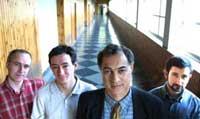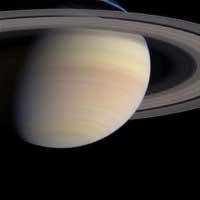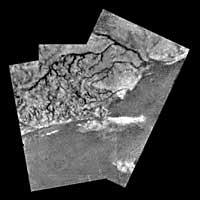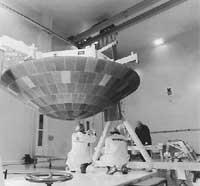Cassini about to reach Saturn
2004/06/28 Agirre Ruiz de Arkaute, Aitziber - Elhuyar Zientzia

But the probe is about to reach Saturn. Yes, there you cannot land as on Mars. It will have to remain in the orbit of the planet, as Saturn is a giant ball of hydrogen and helium. According to astrophysicist Agustín Sanchez-Lavega "If a spacecraft landed in Saturn, there would be a complete immediate breakdown, as occurred in Galileo Jupiter. The pressure is enormous. Nothing can land on these gas worlds, on these icy worlds."
The Cassini probe, even from the orbit, must solve the greatest mysteries of Saturn. For example, why you have those bright rings. Or how are the 31 satellites that are spinning. It has already been revealed and has sent several photos: the last, of the Black Moon satellite.
But above all, it will analyze the red moon called Titan. After six months in the vicinity of Saturn, the probe will release the robot Huygens, which will land on the surface of Titan, whose crust is solid. They hope to find in Titan's atmosphere similar chemical conditions to those existing before life on Earth. Agustín Sanchez-Lavega highlights the appeal of the mission: "On Titan's surface there seem to be ponds, lagoons or, more so, oceans made up of liquid hydrocarbons. Imagine how spectacular it would be to find oil lakes! Many times we take our hair: if the oil companies knew it, they would like to start exploding Saturn's moon!"

Now scientists are worried about where the Huygens robot will fall. And if it fell in a sea of hydrocarbons they do not know how long the robot would last without spoiling it.
The Cassini mission has another objective: Saturn meteorology study. On this planet there are spectacular storms and strong winds like those that appear in the images: winds of 1,800 kilometers per hour, much stronger than in any hurricane on Earth. Agustín Sanchez-Lavega and his team investigate this from the Bilbao School of Engineering. "It is very interesting to investigate the atmospheric dynamics of Saturn. On the ground, the heat of the Sun causes the movements of the wind, the atmosphere. That is, the Sun illuminates our planet and the Earth absorbs solar radiation. It warms the atmosphere and the planet by turning it sets the atmosphere in motion. That is, in short, the wind. However, being so far from the Sun, very little radiation comes: Only a percentage of those who reach Earth. So how can such a cold planet, with 180 degrees below zero on the surface, have winds of 1,800 kilometers per hour?"

Agustín Sanchez-Lavega has been studying the evolution of Saturn's clouds for 10 years. In his opinion, knowing the weather of Saturn will help us discover the terrestrial. At the moment, on Earth we can predict a maximum time of 5 days. "When we want to try an example of the atmosphere of our planet, we must do it on Earth. However, meteorology can be studied based on the validity of these models on other planets. In laboratories we cannot make a sphere in which gas flows, it is impossible. Therefore, the most suitable laboratories are other planets of the solar system."
These researchers expect data sent by Cassini and Huygens. At the moment, the probes must be content to arrive correctly, as it is often the greatest difficulty of space missions.

Gai honi buruzko eduki gehiago
Elhuyarrek garatutako teknologia






